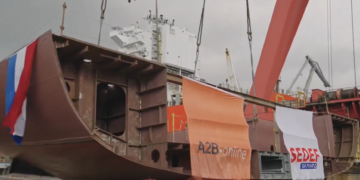The world economy will grow by 3.7% in real terms in 2018 as previously mentioned. The growth expectation for the year 2017 was 3.6%. In brief, it will be a year of the same course with almost the same level of economic growth on a global scale. (Rising and improving economies will grow by 4.9% and developed economies will grow by 2%.)
In 2018, the expected growth in demand for the maritime transportation market is slightly lower than the realized growth rates in 2017. (Actually, although the expectation in 2017 was not very high, realized growth was obviously higher than expected as announced.)
Expected growth rates in 2018 are as follows;
The amount of cargo transported via sea transportation will increase by 3.6% in tonnes and be 12.018 million tonnes and will increase by 4% in tonnes/mile and be 60.149 billion tonnes/mile in 2018.
The increase rates according to cargo types will be as follows. (Figures in paranthesis are the rate of increase in 2017);
Iron Ore 3.2% (5.3%), Coal 1.9% (5.2%), Grain 1.8% (6.4%), Minor Bulk 3.2% (2.7%), Crude Oil 2.8% (2.8%), Petrol Derivatives 3.2% (2.8%), Gas 10.9% (8.7%), Chemical 3.9% (4.0%), Container 5.2% (5.3%), Other Dry Cargoes 3.9% (4.2%).
If it is paid close attention, the increase in demand for crude oil is almost the same as in 2017, and a slight increase is expected on petrol derivatives. While container and chemical cargoes are stable, gas trade shows an increase especially in terms of LNG. On dry bulk cargo, a decline is expected in terms of grain and coal. A slight increase is expected on minor bulk like almost on petrol derivatives. (All these estimates are obtained from Clarkson’s December Report.)
The types and percentages of cargoes which will have the largest percentage in maritime transportation in 2018 will be approximately as follows; (The first 6 cargoes in the order)
Crude Oil 17.1%, Container 15.9%, Major Bulk 27.3% (Iron Ore 12.8%, Coal 10.2%, Grain 4.3%), Minor Bulk 16.4%, and Petrol Derivatives 9.4%.
In 2017, the Maritime Transportation showed an average increase well above 3.2% and 3.5% which are the values of 10-year CAGR, based on both the ton and ton/mile. The percentage increase in 2018 will be again above this 10-year growth rates, but be slightly lower than in 2017.
The World Freighter Fleet increased by 3.37% in 2014, 3.29% in 2015, 3% in 2016 by decreasing in rate of increase, and 3.36% in 2017 as of beginning of December, with reference to the previous year. This increase is higher than 2016, but it is a slight increase compared to the historical trend after 2008. The total world fleet value is about 920 billion USD.
The total value of the vessels ordered is 230.7 billion USD.
In spite of the fact that orders in ship building industry are far behind the times of old magnificent years, orders shows relative improvement compared to the crisis period. While the new ship building price index was above 190 in November 2008, it decrased into 135 in November 2009. Then it was seen in about 140, but it decrased into 125 in November 2012 and afterwards it decreased into 120 which is the bottom level in November 2016. Finally in 2017 it was increased slightly to 125 which was the level of 2012.
As to second-hand vessel price market, when the 5-year-old vessel was taken as an example, increase could be observed in tanker and dry bulk since November 2010. Dry bulk tonnage had much better course. Then the prices began to fall and reached 100 index points which is almost same level as in November 2012. Then they increased simultaneously again. While prices of dry bulk vessels were decreasing dating from beginning of 2014, second-hand prices of tankers started to increase dating from November 2014. While vessel prices in dry bulk market reached historical rock bottom, tanker market continued to increase. Then, while tanker market fell, dry bulk market raised. And in 2017, tanker second-hand vessel prices were slighly above the 100 index value. Dry bulk cargo started to follow a flat course slightly below 100 points. In November 2008, the index value of dry bulk tonnage in second-hand market was 150, tanker tonnage was 180. In December 2017, both vessel types declined to index levels of 100-110 points.












